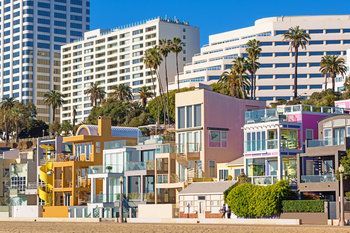 One of the first questions you are bound to ask yourself when you want to buy a home (or even if you already own one) is “which mortgage is right for me?”
One of the first questions you are bound to ask yourself when you want to buy a home (or even if you already own one) is “which mortgage is right for me?”
Basically, purchase and refinance loans are divided into fixed-rate or adjustable-rate mortgages. Once you decide on fixed or adjustable, you will also need to consider the loan term. For some homeowners, there are even options to extract equity out of their home, and these loan options also come in fixed and adjustable-rate varieties, too.
Here is a brief guide to the different types of mortgages available in today’s market.
Fixed-rate mortgage
Long-term fixed-rate mortgages are the staple of the American mortgage market. With a fixed rate and a fixed monthly payment, these loans provide the most stable and predictable cost of homeownership.
This makes fixed-rate mortgages very popular for homebuyers (and refinancers), especially at times when interest rates are low.
The most common term for a fixed-rate mortgage is 30 years, but shorter-terms of 20, 15 and even 10 years are also available. A shorter term means a higher monthly payment but much lower overall interest costs. Since a higher monthly payment limits the amount of mortgage a given income can support, most homebuyers decide to spread their monthly payments out over a 30-year term.
Some mortgage lenders will allow you to customize your mortgage term to be whatever length you want it to be by adjusting the monthly payments. You can also customize your loan term yourself with regular prepayments.
Adjustable-rate mortgage (ARM)
Since monthly payments can both rise and fall, ARMs carry risks that fixed-rate loans do not. ARMs are useful for some borrowers -- even first time borrowers -- but do require some additional understanding and diligence on the part of the consumer. There are knowable risks, and some can be managed with a little planning. To get a better understanding of adjustable-rate mortgages and how they work, read HSH.com’s guide to adjustable-rate mortgages.
Hybrid ARMs
Almost a "best of both worlds" product, Hybrid ARMs offer initial fixed interest rate periods of three, five, seven or 10 years; after that, they most frequently turn into a 1-year ARM, where the interest rate will change every year thereafter. However, this is changing, at least for ARMs eligible to be sold to Fannie Mae or Freddie Mac; these hybrid ARMs are linked to the SOFR index, and feature interest rate adjustments every six months after the initial fixed-rate period ends.
Hybrid ARMs are the most common form of ARM found in the market today.
Like traditional ARMs, these are usually available at lower rates than fixed-rate mortgages and have total repayment terms of 30 years. Because they have a variety of fixed-rate periods, Hybrid ARMs offer borrowers a lower initial interest rate and a fixed-rate mortgage that fits their expected time frame.
That said, these products carry risks since a low fixed rate (for a few years) could come to an end in the middle of a higher-rate climate, and monthly payments can jump. Because of this, Hybrid ARMs are best for borrowers who are very certain about how long they plan on remaining in the home, or those who have the wherewithal to manage any payment increase in the future.
Traditional ARMs
Traditional ARMs trade long-term stability for regular changes in your interest rate and monthly payment. This can work to your advantage or disadvantage.
Traditional ARMs have interest rates that adjust every year, every three years or every five years. You may hear these referred to as "1/1,” "3/3” or "5/5" ARMs. These refer to how frequently the rate changes and how long the new rate remains. For example, initial interest rate in a 5/5 ARM is fixed for the first five years. After that, the interest rate resets to a new rate every five years until the loan reaches the end of its 30-year term.
Traditional ARMs are usually offered at a lower initial rate than fixed-rate mortgages, and usually have repayment terms of 30 years. Depending upon where interest rates are, high or low, these products may offer you a chance to get a lower rate today, enjoy that for a few years and then get an even lower rate in the future. Of course, the reverse is true, and you could end up with a higher rate, making your mortgage less affordable in the future.
Note: Not all lenders offer these products. Traditional ARMs are more favorable to homebuyers when interest rates are fairly high, since they offer the chance at lower rates in the future.
FHA Loans
Although often discussed as though it is one, FHA isn't a mortgage. It stands for the Federal Housing Administration, a government entity which essentially runs an insurance pool supported by fees that FHA mortgage borrowers pay. This insurance pool virtually eliminates the risk of loss to a lender, so FHA-backed loans can be offered to riskier borrowers, especially those with lower credit scores and smaller down payments.
FHA backs both fixed- and adjustable-rate mortgage products. Popular among first-time homebuyers, the 30-year fixed-rate FHA-backed loan is available at rates even lower than more traditional "conforming" mortgages, even in cases where borrowers have weak credit.
While down payment requirements of as little as 3.5 percent make them especially attractive, borrowers must pay an upfront and annual premium to fund the insurance pool noted above. These may also compete with other low downpayment mortgages in the market, such as HomeReady and HomePossible options.
To learn more about FHA mortgages, read “Advantages of FHA mortgages.”
VA Loans
VA loans are mortgages guaranteed by the U.S. Department of Veterans Affairs (VA). These loans, issues by private lenders, are offered to eligible servicemembers and their families at lower rates and at more favorable terms.
To determine if you are eligible and to learn more about these mortgages, visit our VA home loans page.
USDA Loans
Like FHA-backed loans, USDA loans aren't actually a different kind of mortgage. Rather, this government agency operates mortgage programs that are backed by the U.S. Department of Agriculture, including their Guaranteed Loan and Direct Loan programs. The Direct Loan program is aimed at low and very low income buyers, where the Guaranteed Loan program is aimed at moderate income buyers (defined as income up to 80% of the area's median income). The appeal of USDA-backed loans is that, like VA loans, While it's also true that these programs also are only available for "rural" homebuyers, you might be surprised to learn that areas very close to major metropolitan areas are often eligible. There's a lot to know before considering a USDA-backed loan, but you can learn more about USDA mortgage programs at HSH.com.
Jumbo Mortgages
Also not a kind of loan, a "jumbo loan" refers specifically to the size of the loan being borrowed. Fannie Mae and Freddie Mac have limits on the size of mortgages they can buy from lenders; in most areas this cap is $806,500 (up to $1,209,750 in certain "high-cost" markets). Loan amounts above what Fannie and Freddie can purchase in a given area are referred to as jumbo mortgages. Jumbo mortgages come in fixed and adjustable (traditional and hybrid) varieties.
QM and Non-QM mortgages
Under regulations imposed by Dodd-Frank legislation, a definition for a so-called Qualified Mortgage was set. Essentially, a QM is a standard mortgage with no "risky" features such as interest-only payments, balloon payments, 40-year terms and other items. QMs also allow for borrower debt-to-income levels of 43% or less, and can be backed by Fannie Mae and Freddie Mac. Presently, Fannie Mae and Freddie Mac are using special "temporary" exemptions from QM rules to buy or back mortgages with DTI ratios as high as 50% in some circumstances.
Non-QM mortgages can include interest-only payments, alternative income and asset documentation, 40-year terms and other features. Non-QM mortgages may be offered by lenders, who usually put them in their "portfolio" of loans they hold. For the most part, they are made only to the best qualify borrowers or those who have strong risk-offsetting financial characteristics, such as a large down payment or very high levels of assets. Currently, most non-QM mortgages are made to jumbo mortgage borrowers.
Conventional mortgage loans
The term "conventional loan" was originally to discern a mortgage made with private lender funds from a "government loan", which most commonly refers to FHA, VA, USDA and other federal government-backed mortgage offerings. "Conventional, conforming loans" are those made with private lender funds but adhere to a set of standards that make them eligible to be sold and securitized by Fannie Mae or Freddie Mac (in this way, they "conform" to these guidelines for contract structure, loan terms, credit scores of borrowers, down payments, insurance requirements and so on.)
Reverse Mortgages / HECMs
Reverse mortgages and Home Equity Conversion Mortgages (HECMs) are a different kind of mortgage altogether. These are products that allow a homeowner over 62 years of age to use built-up equity they have in their home, and receive these funds in several ways, from a lump-sum disbursement, to a regular annuity-style structure to a line of credit arrangement. All of these options don't require the borrower to make any monthly payments, but instead create a debt obligation that is required to be paid when the borrower no longer occupies the home. These can be complicated products to understand, and have a number of nuances. If you are interested in how these work and who they might work for, we suggest you read our Comprehensive Guide to Reverse Mortgages and HECMs.
Image: Travellinglight/iStock



